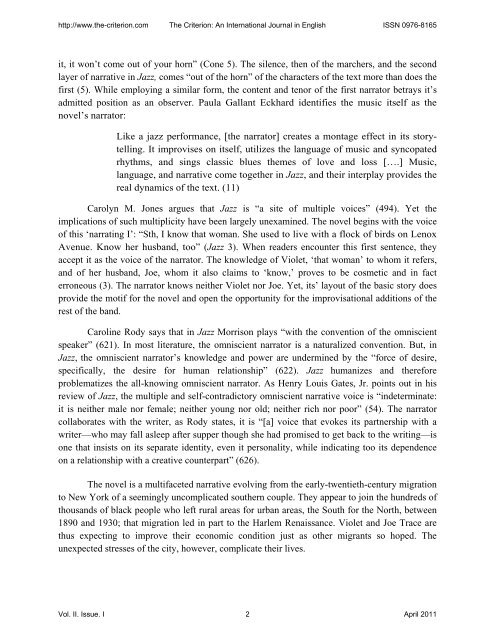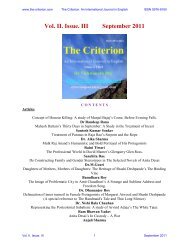Narration and Intertextuality in Toni Morrison's Jazz - The Criterion ...
Narration and Intertextuality in Toni Morrison's Jazz - The Criterion ...
Narration and Intertextuality in Toni Morrison's Jazz - The Criterion ...
Create successful ePaper yourself
Turn your PDF publications into a flip-book with our unique Google optimized e-Paper software.
http://www.the-criterion.com <strong>The</strong> <strong>Criterion</strong>: An International Journal <strong>in</strong> English ISSN 0976-8165<br />
it, it won’t come out of your horn” (Cone 5). <strong>The</strong> silence, then of the marchers, <strong>and</strong> the second<br />
layer of narrative <strong>in</strong> <strong>Jazz</strong>, comes “out of the horn” of the characters of the text more than does the<br />
first (5). While employ<strong>in</strong>g a similar form, the content <strong>and</strong> tenor of the first narrator betrays it’s<br />
admitted position as an observer. Paula Gallant Eckhard identifies the music itself as the<br />
novel’s narrator:<br />
Like a jazz performance, [the narrator] creates a montage effect <strong>in</strong> its storytell<strong>in</strong>g.<br />
It improvises on itself, utilizes the language of music <strong>and</strong> syncopated<br />
rhythms, <strong>and</strong> s<strong>in</strong>gs classic blues themes of love <strong>and</strong> loss [….] Music,<br />
language, <strong>and</strong> narrative come together <strong>in</strong> <strong>Jazz</strong>, <strong>and</strong> their <strong>in</strong>terplay provides the<br />
real dynamics of the text. (11)<br />
Carolyn M. Jones argues that <strong>Jazz</strong> is “a site of multiple voices” (494). Yet the<br />
implications of such multiplicity have been largely unexam<strong>in</strong>ed. <strong>The</strong> novel beg<strong>in</strong>s with the voice<br />
of this ‘narrat<strong>in</strong>g I’: “Sth, I know that woman. She used to live with a flock of birds on Lenox<br />
Avenue. Know her husb<strong>and</strong>, too” (<strong>Jazz</strong> 3). When readers encounter this first sentence, they<br />
accept it as the voice of the narrator. <strong>The</strong> knowledge of Violet, ‘that woman’ to whom it refers,<br />
<strong>and</strong> of her husb<strong>and</strong>, Joe, whom it also claims to ‘know,’ proves to be cosmetic <strong>and</strong> <strong>in</strong> fact<br />
erroneous (3). <strong>The</strong> narrator knows neither Violet nor Joe. Yet, its’ layout of the basic story does<br />
provide the motif for the novel <strong>and</strong> open the opportunity for the improvisational additions of the<br />
rest of the b<strong>and</strong>.<br />
Carol<strong>in</strong>e Rody says that <strong>in</strong> <strong>Jazz</strong> Morrison plays “with the convention of the omniscient<br />
speaker” (621). In most literature, the omniscient narrator is a naturalized convention. But, <strong>in</strong><br />
<strong>Jazz</strong>, the omniscient narrator’s knowledge <strong>and</strong> power are underm<strong>in</strong>ed by the “force of desire,<br />
specifically, the desire for human relationship” (622). <strong>Jazz</strong> humanizes <strong>and</strong> therefore<br />
problematizes the all-know<strong>in</strong>g omniscient narrator. As Henry Louis Gates, Jr. po<strong>in</strong>ts out <strong>in</strong> his<br />
review of <strong>Jazz</strong>, the multiple <strong>and</strong> self-contradictory omniscient narrative voice is “<strong>in</strong>determ<strong>in</strong>ate:<br />
it is neither male nor female; neither young nor old; neither rich nor poor” (54). <strong>The</strong> narrator<br />
collaborates with the writer, as Rody states, it is “[a] voice that evokes its partnership with a<br />
writer—who may fall asleep after supper though she had promised to get back to the writ<strong>in</strong>g—is<br />
one that <strong>in</strong>sists on its separate identity, even it personality, while <strong>in</strong>dicat<strong>in</strong>g too its dependence<br />
on a relationship with a creative counterpart” (626).<br />
<strong>The</strong> novel is a multifaceted narrative evolv<strong>in</strong>g from the early-twentieth-century migration<br />
to New York of a seem<strong>in</strong>gly uncomplicated southern couple. <strong>The</strong>y appear to jo<strong>in</strong> the hundreds of<br />
thous<strong>and</strong>s of black people who left rural areas for urban areas, the South for the North, between<br />
1890 <strong>and</strong> 1930; that migration led <strong>in</strong> part to the Harlem Renaissance. Violet <strong>and</strong> Joe Trace are<br />
thus expect<strong>in</strong>g to improve their economic condition just as other migrants so hoped. <strong>The</strong><br />
unexpected stresses of the city, however, complicate their lives.<br />
Vol. II. Issue. I 2 April 2011
















